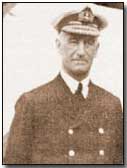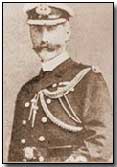Battles - The Attempt on the Dardanelles Narrows, 1915
 Having paused to consolidate following the
clear failure of the previous month's attempts to batter the Turkish protective
fortresses, a further naval effort was briefly launched on 18 March in an
attempt to break through The Narrows: so-named because just 1,600
heavily-mined metres separated the shore on either side.
Having paused to consolidate following the
clear failure of the previous month's attempts to batter the Turkish protective
fortresses, a further naval effort was briefly launched on 18 March in an
attempt to break through The Narrows: so-named because just 1,600
heavily-mined metres separated the shore on either side.
The naval attacks upon the Dardanelles Straits on 19 & 26 February had nevertheless succeeded in achieving the first element of naval Commander-in-Chief Sir Sackville Carden's three-point blueprint for seizing control of the Straits and thus access to Constantinople and a supply route to Britain's ally in the east, Russia.
The Straits - 65km in length and 7km in width (aside from 'The Narrows') were overlooked by steep and heavily fortified cliffs: the Gallipoli peninsula to the northwest and the coast of Asia Minor to the south. Navigation through the wildly varying current was additionally considered problematic.
Carden's plan was three-fold. He recognised that simple bombardment of the overlooking Turkish fortresses was impractical.
He proposed instead that the forts' outer guns should first be neutralised via long-range gunfire, the battleships out of effective range of the fortress guns. This accomplished an Allied fleet would progress further up the Straits to The Narrows to enable medium-range artillery to destroy shore batteries while minesweepers wiped out probable minefields blocking their path. The final phase envisaged the destruction of the inner forts.
 Thus
with stage one
achieved - the outer forts (Cape Helles and Kum Kale) had fallen to the
marines - Sir
Winston Churchill, the British First Lord of the Admiralty, ordered
Carden to proceed to stage two, capture of the Narrows.
Thus
with stage one
achieved - the outer forts (Cape Helles and Kum Kale) had fallen to the
marines - Sir
Winston Churchill, the British First Lord of the Admiralty, ordered
Carden to proceed to stage two, capture of the Narrows.
The attack was to be launched on 18 March 1915, five days following a further minesweeping failure along the Straits. Immediately before the attack's launch however Carden collapsed from nervous exhaustion. He was replaced by Sir John de Robeck.
The renewed attack by sixteen battleships plus many other smaller vessels, and which stretched up to 10km up the Straits, proved a heavy failure, chiefly on account of the presence of an unsuspected drifting minefield set on 8 March. Five Allied warships were sunk or disabled by mines during the operation: the British Inflexible, Irresistible and Ocean; and the French Bouvet and Gaulois (the latter caused great political damage to the French naval minister who had backed the British plan, Jean Augagneur, eventually leading to his replacement).
Distraught by the experience de Robeck insisted that no further attempt be made until ground troops had been landed and given time to capture the high ground around the Narrows. He maintained this view even under heavy pressure from such political heavyweights as Winston Churchill, the First Lord of the Admiralty, and his own fiery Chief of Staff Roger Keyes, refusing to countenance a further attack which he believed would inevitably fail at heavy cost. In this he was backed by the professional staff at the Admiralty in London.
As a consequence of de Robeck's stance he came under sustained criticism from those who felt that he had in effect doomed the whole Dardanelles campaign to failure. Sir Ian Hamilton, Commander-in-Chief of the Mediterranean Expeditionary Force (appointed on 12 March by war minister Lord Kitchener even before the failed naval attempt), subsequently agreed to attempt to capture land dominating the Narrows in a meeting held with de Robeck four days after the failed attack.
 On
23 March Churchill reported to the War Cabinet his reluctant view that the
naval attack upon the Straits had failed.
On
23 March Churchill reported to the War Cabinet his reluctant view that the
naval attack upon the Straits had failed.
His own political career damaged, the dramatic resignation of First Sea Lord Admiral Fisher - who had never held any great confidence in the plan and who resented Churchill's 'misuse' of 'spare' battleships - brought about Churchill's own political demise.
For all that the naval attempts had failed the Turkish defenders had run critically short of ammunition. Liman von Sanders, the German officer appointed in March to take charge of defensive operations, suspected that a follow-up attack by the Allies might well succeed. He was consequently elated once realisation dawned that no follow-up assault was forthcoming.
Instead he had time available to reconsolidate the Turkish defence for a combined Allied naval/ground offensive. In the event he was given rather more time than he could have hoped for: Allied landings on the peninsula took some five weeks to co-ordinate, by which time Liman's sophisticated defences were in readiness.
To view maps detailing the progress of the Gallipoli campaign click here; and here; and here; and here.
Click here to read the reaction of the U.S. Ambassador to Turkey to the failed attack, Henry Morgenthau. Click here to read a summary of events in February and March 1915 by noted journalist Henry Nevinson.
Photographs courtesy of Photos of the Great War website
A "British warm" was a heavy issue greatcoat for officers.
- Did you know?
